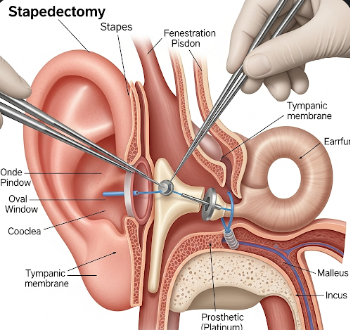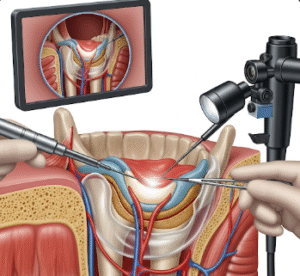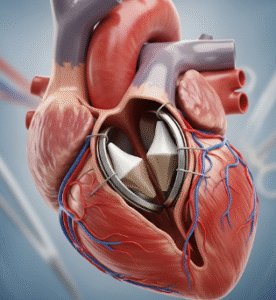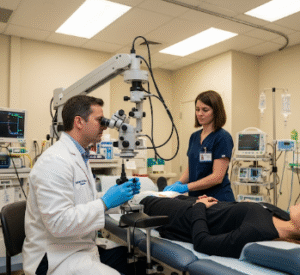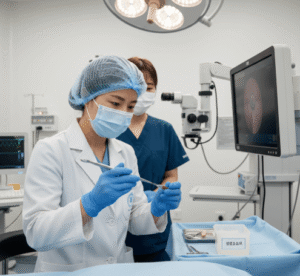Overview
Stapedectomy is a surgical procedure of the middle ear aimed at treating hearing loss caused by otosclerosis, a condition in which the stapes bone becomes fixed and unable to vibrate. By removing or bypassing the immobilized stapes and replacing it with a prosthesis, the surgery restores sound transmission to the inner ear, significantly improving hearing.
In Korea, stapedectomy is performed in highly specialized ENT (Ear, Nose, Throat) and audiology centers, using microsurgical techniques, state-of-the-art equipment, and expert postoperative care. Patients benefit from precision surgery, low complication rates, and effective restoration of hearing.
What is Stapedectomy?
Stapedectomy involves removing all or part of the stapes bone in the middle ear and replacing it with a small prosthetic device to allow sound waves to reach the inner ear.
Key features include:
- ✦ Microsurgical precision – performed under an operating microscope.
- ➤ Prosthetic replacement – usually made of titanium or Teflon for optimal sound conduction.
- ✦ Minimally invasive – typically through the ear canal with no external incision.
- ➤ Improves conductive hearing loss – restores vibration of the ossicular chain.
This surgery is highly effective in patients with otosclerosis, with a success rate of over 90% for hearing improvement.
What are the Benefits?
Stapedectomy provides multiple advantages:
✅ Significant hearing improvement – restores conductive hearing loss caused by stapes fixation.
➤ Minimally invasive approach – no external scars and fast recovery.
✦ Improves quality of life – better communication, reduced social isolation, and enhanced daily functioning.
➤ Low complication rates – advanced microsurgical techniques minimize risk.
✅ Permanent solution – unlike hearing aids, surgery addresses the structural cause.
✦ Quick outpatient procedure – often performed as a day surgery in Korea.
Procedure Details
1) How should I prepare for Stapedectomy?
Preparation steps include:
- ✦ Comprehensive ENT evaluation – hearing tests, CT scan of the temporal bone, and medical history review.
- ➤ Medication adjustments – stopping blood thinners or medications that increase bleeding risk.
- ✦ Fasting – typically 6–8 hours before surgery.
- ➤ Discussion with surgeon – understanding procedure, risks, benefits, and prosthesis type.
- ✦ Consent – acknowledging possible outcomes and rare complications.
- ➤ Preoperative audiology counseling – expectations for hearing improvement and recovery.
2) What happens during the procedure Stapedectomy?
The surgery is performed under local or general anesthesia and usually takes 1–2 hours:
➤ Step 1: Patient is positioned, and the ear canal is sterilized.
✦ Step 2: A small incision or tympanomeatal flap is made in the ear canal.
➤ Step 3: The stapes bone is carefully removed or partially removed.
✦ Step 4: A prosthetic device (e.g., titanium or Teflon piston) is inserted to replace the stapes and connect to the inner ear.
➤ Step 5: Surgical site is closed, and a protective dressing is applied.
Microsurgical techniques ensure minimal trauma, precise prosthesis placement, and optimal hearing restoration.
3) What happens after a Stapedectomy?
Post-operative care includes:
- ✦ Hospital stay: usually outpatient or overnight observation.
- ➤ Pain management: mild analgesics for post-operative discomfort.
- ✦ Ear protection: avoid water exposure, pressure changes, and nose blowing for several weeks.
- ➤ Follow-up hearing tests: to evaluate prosthesis function and hearing improvement.
- ✦ Monitoring for complications: dizziness, tinnitus, or infection.
- ➤ Return to normal activities: gradual, typically within 1–2 weeks for light activities.
Most patients experience noticeable hearing improvement within days to weeks, with full recovery over a few months.
Risks / Benefits
Potential Risks:
- ✦ Temporary or permanent dizziness or imbalance.
- ➤ Tinnitus – ringing in the ears.
- ✦ Taste disturbances – due to chorda tympani nerve manipulation.
- ➤ Hearing loss – rare, but possible if inner ear structures are affected.
- ✦ Infection or bleeding in the middle ear.
Benefits:
- ✅ Significant restoration of hearing in patients with otosclerosis.
- ✅ Minimally invasive, microsurgical precision.
- ✅ Permanent structural solution compared to hearing aids.
- ✅ Improved quality of life and communication.
Recovery and Outlook
Recovery from stapedectomy is generally smooth:
- ➤ Hospital stay: usually same day or overnight.
- ✦ Return of normal activities: light activities within 1–2 weeks.
- ➤ Full hearing improvement: often within days, with continued improvement over several weeks.
- ✦ Follow-up audiology: essential for monitoring prosthesis function and hearing gain.
- ➤ Long-term outcome: most patients regain near-normal hearing with minimal complications.
When To Call the Doctor
Contact your healthcare provider if you notice:
⚠ Severe dizziness or vertigo lasting more than a few days.
⚠ Persistent ear pain, swelling, or discharge.
⚠ Sudden hearing loss or worsening tinnitus.
⚠ Signs of infection: fever, redness, or drainage from ear.
⚠ Balance problems or facial nerve weakness.
Best Korea Option / Process
Korea provides world-class stapedectomy care with:
- ✦ Experienced ENT surgeons skilled in microsurgical ear procedures.
- ➤ Advanced operating microscopes and microsurgical tools for precise prosthesis placement.
- ✦ Comprehensive pre- and post-operative audiology support.
- ➤ Minimally invasive techniques for faster recovery and minimal scarring.
- ✦ Affordable and accessible treatment for international patients.
- ➤ Multidisciplinary teams including anesthesiology, nursing, and rehabilitation for optimal outcomes.
Korea is a leading destination for stapedectomy, ensuring safe, effective, and precise hearing restoration with excellent long-term results.
Highlights of Stapedectomy in Korea
- ✅ Microsurgical precision for effective hearing restoration.
- ➤ Minimally invasive procedure with no external scars.
- ✦ Improves quality of life by restoring hearing and communication.
- ➤ Performed by top Korean ENT surgeons with advanced audiology support.
- ✅ Quick recovery with outpatient or short hospital stay.

